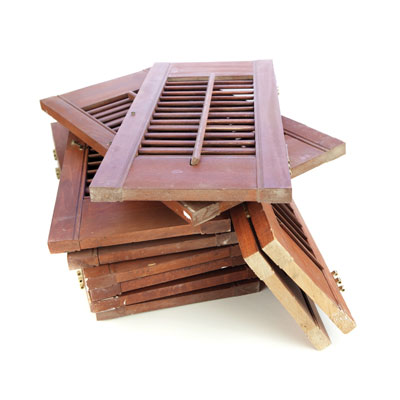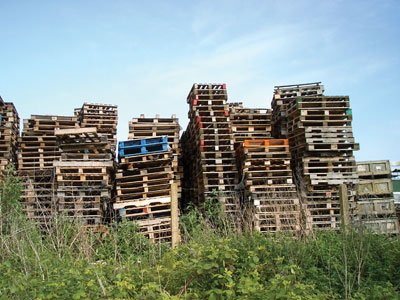
No retail business has more challenges than the garden centre,
No retail business has more challenges than the garden centre, as you not only deal with plant material, giftware and customer service, but you have the added pressure of moisture, watering, excessive sun fading and fluctuating temperatures. Time is of the essence with spring quickly approaching, and space will soon be a commodity that you won’t be able to neglect.
 |
|
| Old wooden shutters or doors can be hinged together as space dividers or used as risers to maximize display space. Visit www.canadiangardencentre.ca “Web Exclusives” for examples. Advertisement
|
Fabulous merchandising starts with a strong foundation and innovative elements. When your product is living, breathing, growing and constantly evolving, easy transitions are a must to maximize your space and your time. Start with the basics that can easily adapt into several different categories.
Display props
A strong foundation starts with props and fixtures. Think big, as props help to make a statement and draw attention to your merchandise. Many prop items can be acquired for free roadside or relatively inexpensively from your local Habitat for Humanity ReStore. Any item can be transformed with a simple coat of paint, a few cuts or a fresh set of eyes to make what was once old something new again.
 |
|
| With ingenuity and some paint, cast-off pallets like these can be made into multi-level tables on coaster wheels or display benches. Visit www.canadiangardencentre.ca “Web Exclusives” for examples. |
Remember that the larger items are needed to draw attention to your collection of merchandise especially in an open concept shop or greenhouse space. By setting the stage for display success the merchandising changes will happen more frequently and efficiently since the foundation has been laid out properly. Here are a few options:
Doors make incredible backdrops while creating realistic home settings that help sell a lifestyle.
A door laid horizontal on a set of new 4×4 legs can become a trendy table with very little effort or material.
Doors, full size or closet, can be hinged together accordion style to create a divider for open floor space, while providing a backdrop and a solid structure to suspend merchandise.
Wooden chairs, ladders and even shutters can also be painted out to attract attention to table top displays as risers or to add height to the set up.
Old windows are another creative prop that can help stage a space and give you the advantage of a glass writing surface for your sales message.
Pallets are a secret weapon and a wonderful tool to create risers, furniture etc with little to no investment while giving you a larger fixture that helps make a statement. Stack them to make tables and platforms or reconstruct them to build benches to give you a larger surface area to work with.
Incorporating height and a variety of levels in your displays not only adds interest but separates product groupings and helps deciphers categories. Introducing nesting tables, crates and creative risers to displays develops staggered levels. Risers or tables when stacked from the ground up create a pyramid layout which maximizes your use of space by creating a small footprint while building height and creating multiple surface areas to merchandise. The same principle works just as efficiently and successfully for table top or bench displays. Multiple levels allow you to change out the product groupings efficiently block by block.
Constant change
Although its important for your display message to be clear and to the point, there are a few key steps that can help keep your focus, as we should be changing out feature displays on a weekly to biweekly bases. In spring, your customers are in frequently and will be looking for changes. They’re interested in new items each and every time they visit.
I should mention that new doesn’t always need to be a new product. New can also be a new combination of products successfully cross merchandised or a new combination of colours and textures that connect with a new client base. As retailers we need to be visual merchandisers so that our product and the message we communicate connects with as many of our customers as possible.
The more we can change and show our customers the more people we connect with. If we build a display in pinks we may connect with 20 per cent of our clientele, so what about the other 80 per cent? We need to constantly change to show pinks and orange, pinks and purple, pinks and yellow, so that we create the opportunity to connect with a larger percentage of our client base.
When planning out your season, mark your calendar to note new product arrivals and possible product combinations. Plan your strategy. What props, fixtures backdrops and paint colours will you need to be prepared?
When planning, create a design story and stick to it. Limit the number of items and colours combined to keep the message clear. Remember that you can’t be all things to everyone, we all need to pick our battles and work within our strengths. Most importantly by limiting the number of elements in a feature display you are able to stay focused. Over stuffing your display can easily over-stimulate your customer creating confusion. When product starts to pile up or overlap heavily it decreases the perceived value of your merchandise.
We need to remember that if we don’t take pride in our displays, placing a value on our product, our clients won’t either. Put your best foot forward and plan for success.
With 15 years’ retail expertise, managing stores, training staff and creating dynamic displays, Leslie Groves has experienced retailing at its various stages and has taught retailing at the college level. Her business, LG Retail Consulting, is based in Brantford, Ont.
Print this page